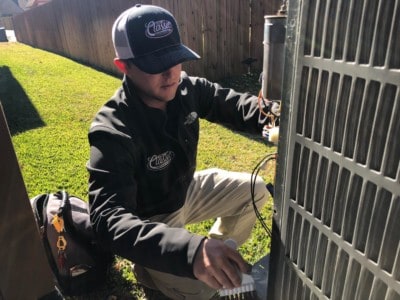This article shows the importance of assessing specific heating and cooling needs before selecting an HVAC system to ensure optimal comfort and efficiency. Home size, climate, and energy efficiency ratings are crucial considerations for homeowners. Choosing the right HVAC system type, whether central air, heat pumps, or ductless mini-splits, depends on factors like existing ductwork and regional weather conditions. Additionally, understanding the installation process, including initial consultation, system sizing, and proper installation techniques, is vital for successful HVAC installation.
Regular maintenance, such as annual inspections and filter changes, is highlighted as essential for prolonging system lifespan and optimizing efficiency. We also identify the most common HVAC installation service mistakes, such as choosing the wrong system size, DIY installation attempts, and neglecting post-installation maintenance. We advocate for the reader to look for professional guidance, correct system selection, and adherence to maintenance schedules to ensure long-term HVAC performance, energy efficiency, and indoor comfort.
Assessing Your HVAC Needs
When it comes to heating and cooling systems, homeowners may need extra guidance before installing. That’s why assessing the specific heating and cooling requirements of a home before selecting an HVAC system is essential for optimal comfort and efficiency. There are several factors to remember when deciding on the type of system they want to have at home.
One crucial factor to consider is the size of the home. The square footage directly influences the capacity needed for effective heating and cooling. A system that’s too small for the home will struggle to maintain desired temperatures, leading to discomfort. An oversized system can result in frequent cycling on and off, leading to inefficiency and higher energy bills.
Additionally, the region’s weather plays a significant role in determining the type and size of the HVAC system required. Areas with extreme temperatures, whether hot or cold, may need more robust systems to ensure year-round comfort and efficiency.
Proper evaluation of energy efficiency is also crucial when choosing an HVAC installation system. Energy efficiency ratings provide valuable insights into how effectively a heating or cooling system converts energy into comfort. Selecting an energy-efficient system reduces utility costs and minimizes environmental impact, contributing to sustainability efforts.
By thoroughly considering factors such as home size, climate, and energy efficiency, homeowners can make informed decisions, ensuring optimal comfort, lower energy bills, reduced environmental footprint, and getting the right HVAC installation service.
Choosing the Right HVAC System
Every person who is planning to acquire a new HVAC needs to know that choosing the right HVAC (Heating, Ventilation, and Air Conditioning) system is crucial for maintaining optimal comfort and energy efficiency in homes. With several types of HVAC systems available, understanding their differences and suitability for different home configurations and climates is a must.
The three main types of HVAC systems are central air conditioners, furnaces, and heat pumps. Let’s get deep into them.
1. Central Heating and Air:
Central HVAC systems are the most common choice for modern homes. They consist of an indoor unit, typically located in the basement or a utility closet, and an outdoor unit. Central systems are suitable for homes with existing ductwork and are effective in both heating and cooling. However, they may not be ideal for homes without ductwork or for regions with moderate climates where extreme heating or cooling isn’t frequently required.
2. Heat Pumps:
Heat pumps are versatile systems that can provide both heating and cooling. They work by transferring heat between indoor and outdoor air, making them highly efficient in moderate climates. Heat pumps are suitable for homes with moderate heating and cooling needs and can be a cost-effective option for regions with milder winters
3. Ductless Mini-Splits:
Ductless mini-split systems are ideal for homes without existing ductwork or where traditional HVAC systems are impractical. They consist of an outdoor compressor unit and one or more indoor air-handling units mounted on the walls or ceilings. Ductless mini-splits offer zone heating and cooling, allowing for customized comfort in different areas of the home. They are highly efficient and suitable for both small and large homes, providing flexibility in installation and usage.
Now that you know what are the main types of HVAC systems, you can make a better decision when purchasing your new unit and getting the best HVAC installation service.
Understanding the Installation Process
As many people may think, installing an HVAC is not an easy task, so a professional is required to have your new HVAC installation service right at home. Keep reading to learn more about the installation process.
The HVAC installation process typically begins with an initial consultation and site inspection by HVAC professionals. During this stage, homeowners discuss their heating and cooling needs, preferences, and any existing issues with the HVAC contractor. The contractor evaluates the home’s layout, size, insulation, and existing HVAC infrastructure to determine the most suitable system and installation approach.
Following this, detailed calculations are performed to correctly size the new system and calculate the heating and cooling loads, ensuring optimal performance and energy efficiency. Additionally, any necessary upgrades to ductwork or other components are identified to accommodate the new HVAC installation system effectively.
Once the consultation and site inspection are complete, the actual installation process commences. This stage involves several key steps, including selecting the ideal location for the HVAC unit, updating or installing new ducts as needed, and ensuring safety and compliance with relevant regulations.
HVAC technicians carefully handle refrigerant lines, ductwork, and other components to optimize system efficiency and performance. After installation, thorough testing is conducted to verify proper operation and ensure that the new system meets performance standards. This testing phase typically includes checks on airflow, temperature differentials, and overall system functionality to guarantee that the HVAC system functions reliably and efficiently.
If you’re looking for experts to get a top HVAC installation service, ClassicABC provides installation services in Texas. Our technicians are here to guide you in every step of the process so you can enjoy your new system!
Preparing for Installation Day
Get ready for your HVAC installation day by following these tips:
- Clear the area around the installation site: Remove any obstacles, furniture, or objects that may obstruct the path to the installation area. This ensures that technicians have ample space to work efficiently and safely.
- Ensure easy access for technicians: Make sure that the pathways leading to the installation site are clear and easily accessible. Remove any barriers such as snow, debris, or clutter that could impede the technicians’ entry into your home.
Providing a clear and unobstructed pathway will streamline the installation process and help avoid delays. - Communicate any specific instructions: If there are any specific instructions or preferences regarding the installation process, communicate them clearly with the installation team beforehand. This includes any preferences for entry points, parking locations, or other logistical details that may affect the installation process.
- Protect sensitive areas: Take measures to protect sensitive areas of your home, such as floors, walls, and furniture, from potential damage during the installation process. Covering floors with drop cloths or protective sheets can prevent scratches or stains while removing fragile items from the vicinity of the installation site can minimize the risk of accidents.
By following these tips, homeowners can ensure a smooth and hassle-free installation day, allowing the technicians to work efficiently and effectively to complete the installation of their new HVAC system or other home upgrades.
Maintaining Your New HVAC System
During this article we have explained to you the basics of HVAC installation, but… what about maintenance? This section will delve into the important things you need to know about HVAC maintenance and extending your unit’s lifespan.
Regular maintenance is essential for maximizing the lifespan and efficiency of HVAC systems. Firstly, routine maintenance helps identify and address minor issues before they escalate into major problems, thereby extending the overall lifespan of the system.
By scheduling annual inspections conducted by qualified technicians, homeowners can ensure that their HVAC installation services are correct and receive thorough checks for any signs of wear and tear, leaks, or faulty components. Additionally, regular maintenance involves routine filter changes, which play a crucial role in maintaining indoor air quality and preventing dust and debris buildup that can strain the system and reduce efficiency.
Furthermore, consistent maintenance enhances the efficiency of HVAC systems, resulting in lower energy consumption and reduced utility bills. A well-maintained HVAC system operates more smoothly, ensuring optimal performance and avoiding unnecessary strain on its components.
By regularly cleaning or replacing filters, checking refrigerant levels, and lubricating moving parts, homeowners can improve the system’s efficiency and reduce the risk of breakdowns or malfunctions. Therefore, implementing a regular maintenance schedule not only saves money in the long run by reducing repair costs but also contributes to environmental sustainability by minimizing energy waste.
Regular maintenance is crucial for prolonging the lifespan and optimizing the performance of HVAC systems. Homeowners should prioritize scheduling annual inspections and adhering to routine filter changes to ensure the system operates efficiently and effectively throughout its lifespan. By investing in preventive maintenance, homeowners can enjoy improved indoor comfort, lower energy bills, and peace of mind knowing that their HVAC systems are operating at their best.
Common HVAC Installation Mistakes to Avoid
During the HVAC installation process, homeowners often make critical mistakes that can impact the system’s efficiency and longevity. One common error is choosing the wrong size system for their home. Undersized HVAC units struggle to adequately heat or cool the space, leading to increased energy consumption and uneven temperature distribution.
Conversely, oversized units may cycle on and off frequently, resulting in unnecessary wear and tear on components and higher energy bills. To avoid this mistake, homeowners should consult with HVAC installation services professionals who can conduct a thorough assessment of their home’s size, insulation, and layout to determine the appropriate system size.
Another frequent misstep is attempting a DIY installation or hiring inexperienced contractors to save money. HVAC systems are complex and require precise installation to operate efficiently. Skipping professional installation can lead to improper ductwork installation, incorrect wiring, or inadequate airflow, all of which can compromise system performance and pose safety hazards.
While professional installation may seem like an added expense, it ensures that the system is installed correctly and compliant with building codes, reducing the risk of breakdowns and costly repairs down the line.
Moreover, neglecting routine maintenance after installation is a common oversight that can result in premature system failure and decreased efficiency. Many homeowners fail to schedule regular tune-ups and filter changes, allowing dust and debris to accumulate in the system and hinder airflow. Additionally, ignoring minor issues, such as strange noises or reduced airflow, can lead to more significant problems over time.
By establishing a maintenance schedule and addressing issues promptly, homeowners can extend the lifespan of their HVAC installation system and ensure optimal performance throughout its life.
Conclusion
In conclusion, homeowners can avoid these common HVAC installation mistakes by consulting with professionals, investing in the correct size system, prioritizing professional installation, and committing to regular maintenance. These proactive measures not only ensure the proper functioning of the HVAC system but also contribute to energy efficiency, indoor comfort, and long-term cost savings.

